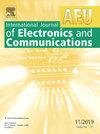Planar H-plane horn antenna with quasi-omnidirectional pattern for 5G applications
IF 3
3区 计算机科学
Q2 ENGINEERING, ELECTRICAL & ELECTRONIC
Aeu-International Journal of Electronics and Communications
Pub Date : 2025-03-06
DOI:10.1016/j.aeue.2025.155752
引用次数: 0
Abstract
This article proposes a quasi-omnidirectional planar H-plane horn antenna having triple-band characteristics, operating in the 5G frequency region centered around 28 GHz. This design comprises four identical substrate integrated waveguide (SIW) based planar H-plane horns. Four coplanar H-plane horns are placed orthogonal to each other to cover the entire 360° azimuth plane, thereby realizing quasi-omnidirectional radiation patterns. The waveguide sections of four H-plane horns are joined at the center location, where a single coaxial probe is connected to excite TE10 mode in the waveguide section. The center conductor of this coaxial probe is not touched with the broad wall of the horn to realize a planar horn antenna in a true sense. Via-based corrugation has been conceived at the flaring section of each horn that improves the impedance bandwidth (IBW) response. Gain has been enhanced by incorporating trapezoidal-shaped dielectric loads at the front of all four horn apertures. The proposed structure exhibits triple operating bands ranging from 25.58 − 26.18 GHz, 26.59–29.12 GHz, and 29.98–30.72 GHz with a stable peak gain of 7.10–7.76 dBi across the operating bands. The measured and simulated results are in good agreement.
求助全文
约1分钟内获得全文
求助全文
来源期刊
CiteScore
6.90
自引率
18.80%
发文量
292
审稿时长
4.9 months
期刊介绍:
AEÜ is an international scientific journal which publishes both original works and invited tutorials. The journal''s scope covers all aspects of theory and design of circuits, systems and devices for electronics, signal processing, and communication, including:
signal and system theory, digital signal processing
network theory and circuit design
information theory, communication theory and techniques, modulation, source and channel coding
switching theory and techniques, communication protocols
optical communications
microwave theory and techniques, radar, sonar
antennas, wave propagation
AEÜ publishes full papers and letters with very short turn around time but a high standard review process. Review cycles are typically finished within twelve weeks by application of modern electronic communication facilities.

 求助内容:
求助内容: 应助结果提醒方式:
应助结果提醒方式:


